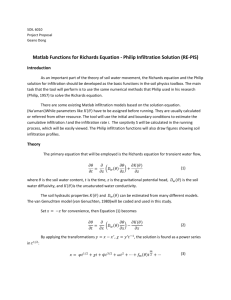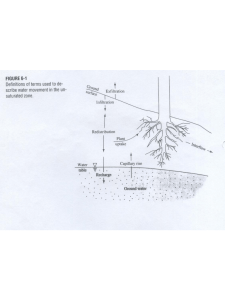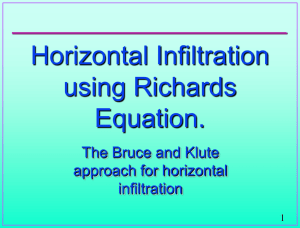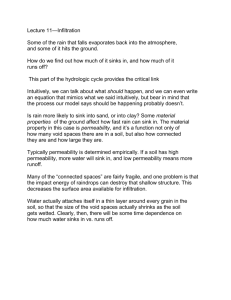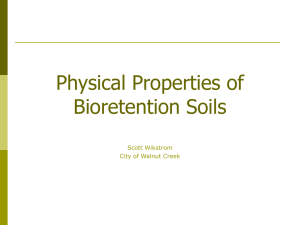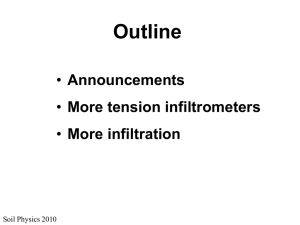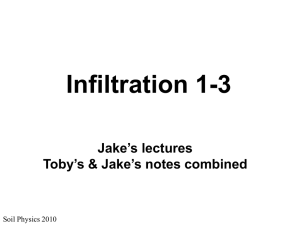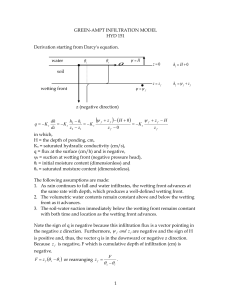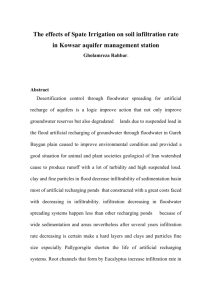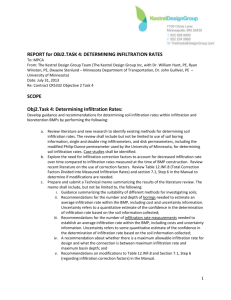Assignment 3
advertisement
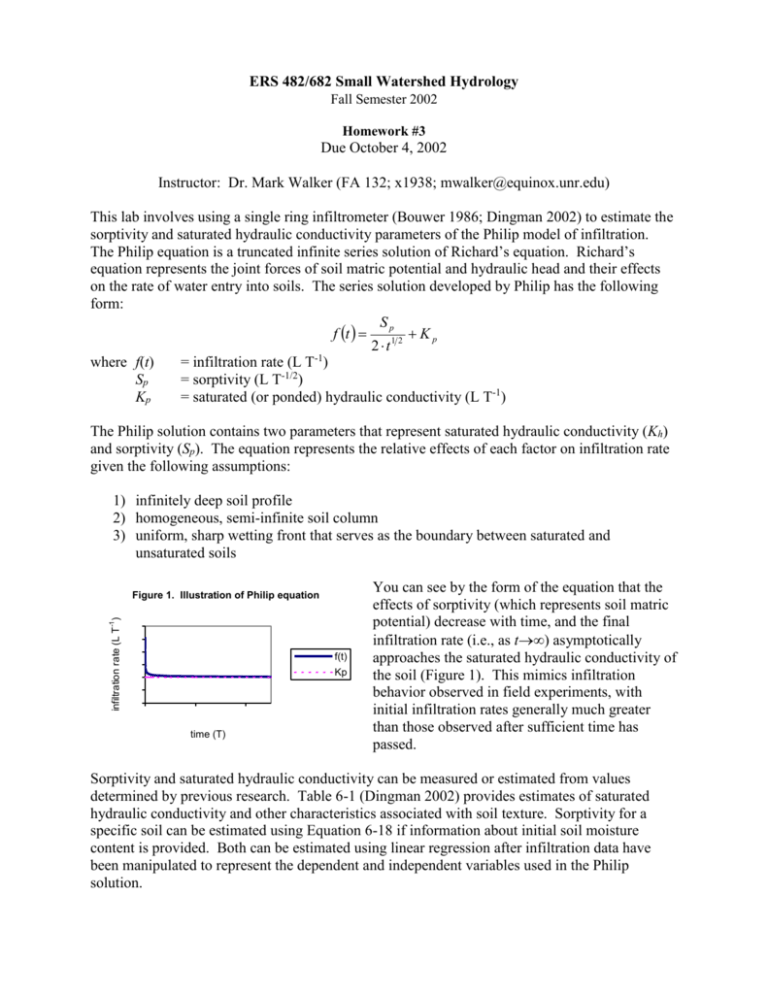
ERS 482/682 Small Watershed Hydrology Fall Semester 2002 Homework #3 Due October 4, 2002 Instructor: Dr. Mark Walker (FA 132; x1938; mwalker@equinox.unr.edu) This lab involves using a single ring infiltrometer (Bouwer 1986; Dingman 2002) to estimate the sorptivity and saturated hydraulic conductivity parameters of the Philip model of infiltration. The Philip equation is a truncated infinite series solution of Richard’s equation. Richard’s equation represents the joint forces of soil matric potential and hydraulic head and their effects on the rate of water entry into soils. The series solution developed by Philip has the following form: Sp f t Kp 2 t1 2 where f(t) = infiltration rate (L T-1) Sp = sorptivity (L T-1/2) Kp = saturated (or ponded) hydraulic conductivity (L T-1) The Philip solution contains two parameters that represent saturated hydraulic conductivity (Kh) and sorptivity (Sp). The equation represents the relative effects of each factor on infiltration rate given the following assumptions: 1) infinitely deep soil profile 2) homogeneous, semi-infinite soil column 3) uniform, sharp wetting front that serves as the boundary between saturated and unsaturated soils infiltration rate (L T-1 ) Figure 1. Illustration of Philip equation 30 25 20 15 10 5 0 f(t) Kp 0 200 time (T) 400 You can see by the form of the equation that the effects of sorptivity (which represents soil matric potential) decrease with time, and the final infiltration rate (i.e., as t) asymptotically approaches the saturated hydraulic conductivity of the soil (Figure 1). This mimics infiltration behavior observed in field experiments, with initial infiltration rates generally much greater than those observed after sufficient time has passed. Sorptivity and saturated hydraulic conductivity can be measured or estimated from values determined by previous research. Table 6-1 (Dingman 2002) provides estimates of saturated hydraulic conductivity and other characteristics associated with soil texture. Sorptivity for a specific soil can be estimated using Equation 6-18 if information about initial soil moisture content is provided. Both can be estimated using linear regression after infiltration data have been manipulated to represent the dependent and independent variables used in the Philip solution. ERS 482/682 (Fall 2002) Homework #3 In this laboratory, you will work in groups of two and obtain two types of measurements to characterize the change in infiltration rates with time under ponded conditions. The first will be an estimate of initial soil water content (0). The second will be a time series of volumes of water added to a single-ring infiltrometer. You will use this information to compare the differences between infiltration estimates made using 1) the changes in infiltration rates with time observed; 2) parameter estimations provided in Table 6-1 and Equation 6-18; and 3) leastsquares regression. Procedures: 1. Obtain starting soil moisture data (0; see Equation 6-6 and use Equation[24] in Gardner 1986). 2. Carry out infiltration experiments with single ring infiltrometers as described by Bouwer (1986). You will apply the following modified method: a. Drive rings into soil to recommended depth. b. Add water to depth of 1” (interior) using a graduated cylinder. Maintain the water level at 1” depth. Record the volume increments added to maintain this water level, and the times at which the water is added. Continue until the infiltration rate approximately stabilizes. Products Expected: Note: Each group should turn in ONE report; be sure to write the names of all of your group members on your report! 1. A graph of infiltration rate as a function of time with four series of infiltration rates: a) infiltration rates you observed (dots) b) corrected infiltration rates based on the critical pressure head hcr and corresponding adjustments according to Figure 32-4 in Bouwer (1986) (squares) c) infiltration rates estimated using values from Table 6-1 and Equation 6-18 (line with no dots) d) infiltration rates determined with parameters estimated from the observed data with the least squares approach in Box 6-2 (Dingman 2002; see Equations 6B2-9, 6B2-8, and 6-31a)) (heavy line) 2. Your estimate of the starting soil moisture content (0), critical pressure head hcr, and the adjustment factor you used to correct the observed infiltration rates 3. Your estimates of saturation hydraulic conductivity (Kp) in cm hr-1 (for series a, b, and c, estimate Kp from your plots; for series d use Equation 6B2-8) 4. Your estimates of sorptivity (Sp) in cm hr-1/2 using Equation 6-18 for series c, and Equation 6B-9 for series d 5. Calculate the correlation coefficient r for series c and series d, using series a as the observed data; provide a short discussion of the strength of the relationships and observed differences or similarities between the four approaches. 6. A comparison of your results from all four approaches with the observed data obtained from the same experiment carried out on other plots by other groups in this lab, including 0 and your estimates of Kp and Sp for each group’s data (estimate Kp from their observed data and 2 ERS 482/682 (Fall 2002) Homework #3 3 use Equation 6-18 to estimate Sp); do not adjust the observed data for the other groups as you did for Item 1b. 7. A discussion of the differences and similarities between results obtained for each group; discuss how experimental technique and soil characteristics might have led to the differences in results. Useful information: Soil fraction composition: 5% fine gravel 65% sand 14% silt 16% clay Using a spreadsheet to estimate Kp and Sp using least squares approach with the Philip equation: Put your observed data into a spreadsheet (one column for time t, one column for calculated infiltration rate based on observation at time t); be sure to use appropriate units! Adjust t so that it represents time from ponding f t 1 1 Create columns to corresponding to f t i , 1 2i , , and 1 2 ; calculate ti ti ti f t 1 1 f t i , 1 2i , , 1 2 t i t i t i Calculate Sp using Equation 6B2-9 (Dingman 2002) Calculate Kp using Equation 6B2-8; note there is an error in the formulation in Dingman 1 2 f ti S p 1 2 ti (2002); the equation should be K p 2N The correlation coefficient provides a measure of how much the variability of the observed data is correlated with the variability of the estimated data. To calculate the correlation coefficient r, you can use the CORREL function in Excel: Syntax CORREL(array1,array2) Array1 is a cell range of values. put the y (estimated) values here Array2 is a second cell range of values put the x (original observed) values here ERS 482/682 (Fall 2002) Homework #3 4 References: Bouwer H. 1986. pp 825-843 in Methods of Soil Analysis – Part I: Physical and Mineralogical Methods. Madison (WI): American Society of Agronomy – Soil Science Society of America. Dingman L. 2002. Physical Hydrology (2nd ed.). Upper Saddle River (NJ):Prentice-Hall. Gardner W. 1986. pp 493-544 in Methods of Soil Analysis – Part I: Physical and Mineralogical Methods. Madison (WI): American Society of Agronomy – Soil Science Society of America.
